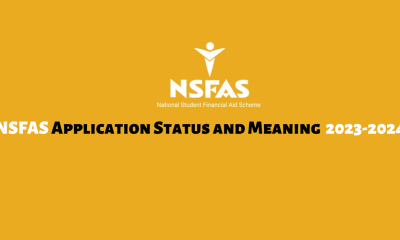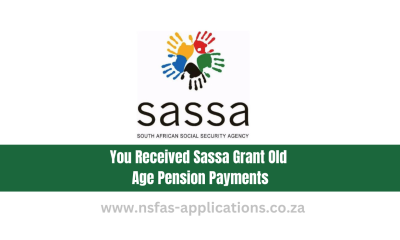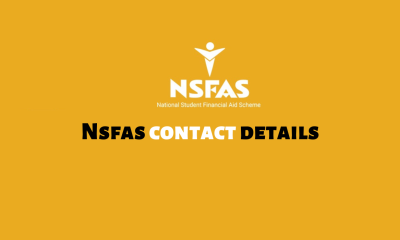NSFAS News
Registration Received NSFAS Meaning

Registration Received NSFAS Meaning. The National Student Financial Aid Scheme (NSFAS) is a vital resource for many South African students pursuing tertiary education. It offers comprehensive financial aid to eligible students attending public universities or Technical and Vocational Education and Training (TVET) colleges. For students navigating the NSFAS process, understanding the various application statuses is crucial.
One such status is “Registration Received,” which can often cause confusion and uncertainty. This article aims to break down what the “Registration Received” status means, its significance, and the next steps you should take.
Registration Received NSFAS Meaning
When you apply for NSFAS funding, your application goes through several stages before the funds are released. The “Registration Received” status indicates that NSFAS has received confirmation of your registration from the educational institution you’ve enrolled in. This is an important milestone in the financial aid process because it signals that you are officially recognized as a student at your university or college and that your funding process is on track.
The Journey to “Registration Received”
Before your application reaches the “Registration Received” stage, it must pass through the following phases:
- Application Submitted: You’ve completed your NSFAS application and submitted it with all the required documents.
- Evaluation: NSFAS reviews your application to verify your eligibility for financial aid, looking at factors like household income, academic standing, and other required criteria.
- Provisionally Funded: If your application meets the eligibility requirements, NSFAS grants provisional funding, pending confirmation of your registration at a public university or TVET college.
Once NSFAS receives confirmation that you are enrolled at the institution, your status changes to “Registration Received,” which signifies that your funding is about to be processed.
Why Is the “Registration Received” Status Significant?
The “Registration Received” status is more than just an acknowledgment; it is a positive signal that you are close to securing financial aid for the academic year. This status means NSFAS has all the necessary information to begin allocating funds for your tuition, registration, and other approved expenses.
Here’s why this status matters:
- Confirmation of Enrollment: NSFAS now has official confirmation from your university or TVET college that you are registered. This means they can begin processing your funding.
- Next Step Towards Funding: Once this status is updated, NSFAS will proceed with disbursing funds to cover your tuition fees, registration costs, and other allowances such as accommodation, transportation, and learning materials (if applicable).
However, it’s important to note that this status does not mean the funds have been paid out yet. It simply means the payment process is underway.
What Should You Do After Receiving the “Registration Received” Status?
Once your NSFAS status changes to “Registration Received,” you are in the final stages of securing your funding. However, there are still a few things you need to do to ensure everything runs smoothly.
1. Monitor Your NSFAS Portal and Email
NSFAS might require additional information from you even after this status update. It’s crucial to keep checking your myNSFAS account and your registered email address for any updates or requests for documentation. Ignoring these communications could lead to delays in receiving your funding.
2. Ensure Your Banking Details Are Correct
If you’re eligible for NSFAS allowances (e.g., for living expenses, books, or transport), these will be paid directly to your student account or bank account. Therefore, it’s essential to ensure that your banking details on the NSFAS portal are accurate and up-to-date.
3. Keep Your Documents Handy
NSFAS may still request additional documentation for final verification. Ensure that all necessary documents, such as proof of income, academic records, and identification documents, are readily available in case they ask for them.
4. Confirm with Your Institution
It’s a good idea to touch base with the financial aid office at your institution. They can provide information on when NSFAS is likely to pay your tuition fees and if there are any other steps you need to take on their end. Also, confirm that your registration has been finalized, as delays on the institution’s side could affect the release of funds.
What Comes After the “Registration Received” Status?
The journey doesn’t end with “Registration Received.” Here’s what to expect next:
1. Verification and Disbursement
After NSFAS confirms your registration, your application enters the verification phase, where NSFAS checks your details against various government databases. This ensures that all the information provided is accurate, and that funding is allocated correctly. Once this is complete, NSFAS will begin disbursing funds to cover your tuition, registration, and allowances (if applicable).
2. Signing the Loan Agreement Form (LAF) or Schedule of Particulars (SOP)
If you’ve applied for a loan (instead of a bursary), NSFAS will require you to sign a Loan Agreement Form (LAF) or Schedule of Particulars (SOP). This is a legally binding agreement that outlines the terms and conditions of your NSFAS loan. Make sure you carefully read through the document before signing it, as it will affect your financial obligations after graduation.
3. Receiving Your Allowances
Once your funding has been approved, NSFAS will also disburse any allowances you are eligible for. These may include:
- Living allowance: To cover basic living expenses like food and utilities.
- Book allowance: To help you purchase necessary learning materials.
- Accommodation allowance: If you live away from home while studying, NSFAS may provide funding for your accommodation.
These allowances are typically paid directly to your student card or bank account. Make sure to check with your institution on how the disbursement will work.
FAQs About the “Registration Received” Status
How long does it take to receive funding after my status changes to “Registration Received”?
The exact timing can vary depending on several factors, such as the volume of applications NSFAS is processing and how quickly your institution confirms your registration. Generally, it can take a few weeks for the funds to be disbursed after the status changes.
What if my application is stuck at “Registration Received” for too long?
If your application remains in this status for an extended period without any updates, it might be worthwhile to contact NSFAS directly for clarification. You can do this by calling their toll-free number or sending an inquiry through the NSFAS portal.
What happens if my application is rejected after reaching this stage?
In rare cases, NSFAS may still reject an application even after receiving registration confirmation. This typically happens if they find discrepancies during the verification process. If this happens, you can submit an appeal by following the steps outlined on the NSFAS portal.
Conclusion
The “Registration Received” status is a pivotal moment in the NSFAS funding process, signaling that you are one step closer to securing financial support for your education. While this status indicates that your registration has been confirmed, it is essential to remain proactive by monitoring your NSFAS portal, ensuring your banking details are accurate, and promptly responding to any additional requests for information.
For thousands of South African students, NSFAS is the bridge between their educational aspirations and the financial means to achieve them. Understanding the significance of each step in the application process, especially critical updates like “Registration Received,” can make all the difference in ensuring a smooth path to academic success. Keep informed, stay prepared, and your educational dreams can soon become a reality.
-

 blog1 year ago
blog1 year agoNSFAS Application Status and Meaning 2023-2024
-

 sassa4 months ago
sassa4 months agoYou Can Now Apply for a Basic Income Grant of R999
-

 sassa4 months ago
sassa4 months agoFinally New Grant of R999 for Basic Income Introduced
-

 sassa4 months ago
sassa4 months agoGood News New Grant of R999 for Basic Income Introduced
-

 sassa1 year ago
sassa1 year agoYou Received Sassa Grant Old Age Pension Payments
-

 blog4 months ago
blog4 months agoNsfas contact details – How to Contact NSFAS 2025-2026
-

 sassa4 months ago
sassa4 months agoNew Verification Method for SRD R350 Grants From Sassa
-

 NSFAS News2 months ago
NSFAS News2 months agoRegistering your accommodation properties with NSFAS
